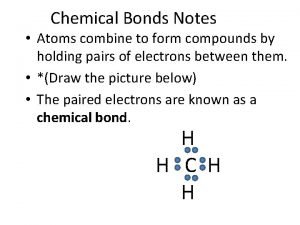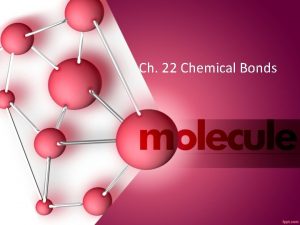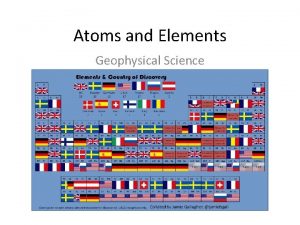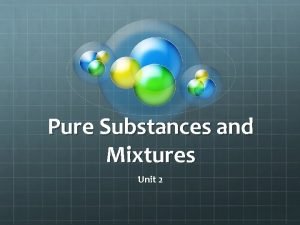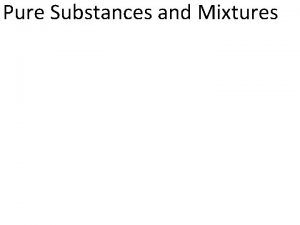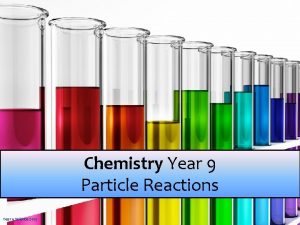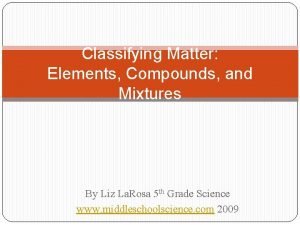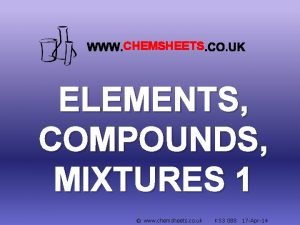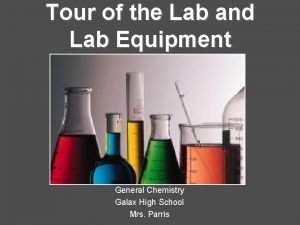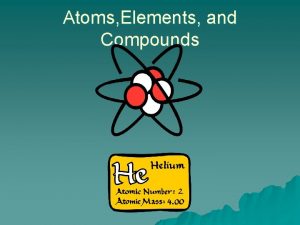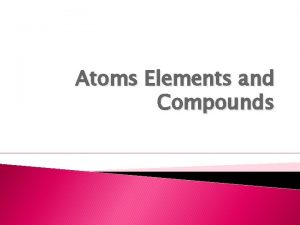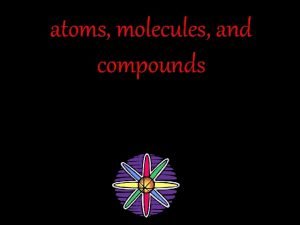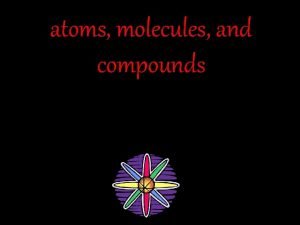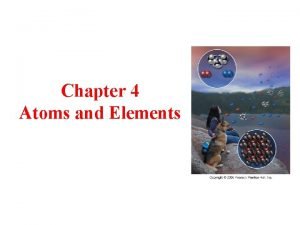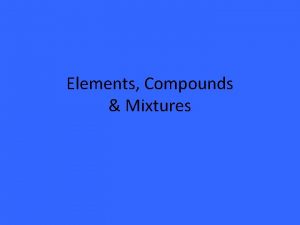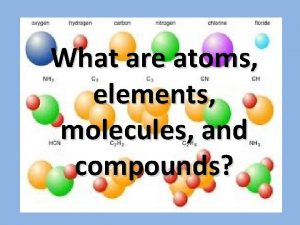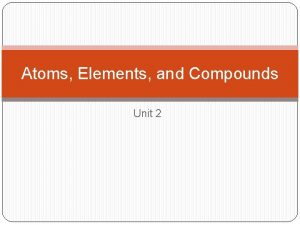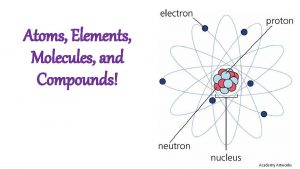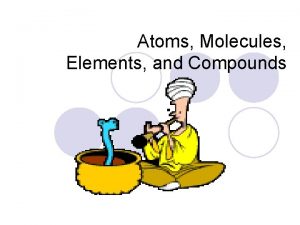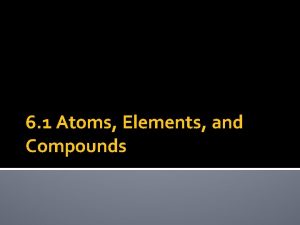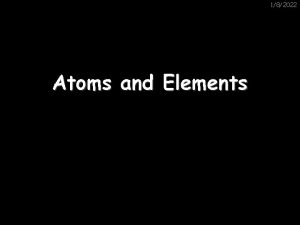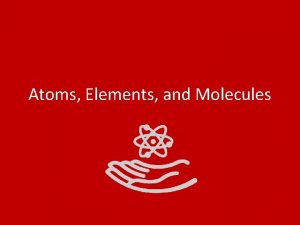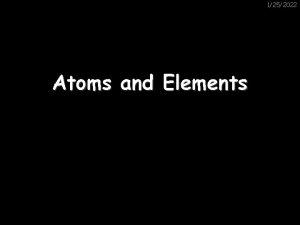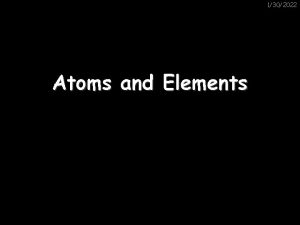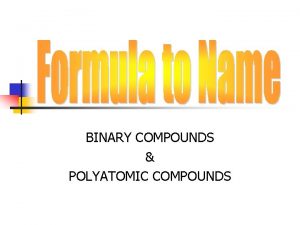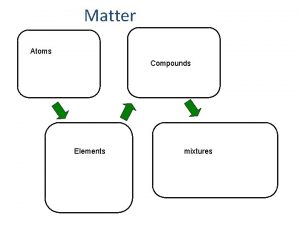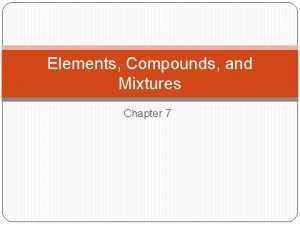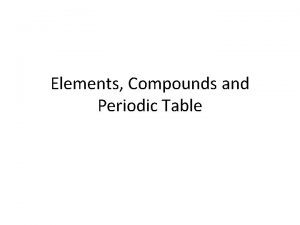Atoms Elements and Compounds Chapter 7 Elements and





















- Slides: 21


Atoms, Elements, and Compounds

Chapter 7: Elements and the Periodic Table • 7. 1 The Periodic Table • 7. 2 Properties of the Elements

Investigation 7 A The Periodic Table • What is the periodic table and how many elements are there?

7. 1 Physical properties • Characteristics that you can see through direct observation are called physical properties. • Physical properties include color, texture, density, brittleness, and state (solid, liquid, or gas). • Melting point, boiling point, and specific heat are also physical properties.

7. 1 Chemical properties • Properties that can only be observed when one substance changes into a different substance are called chemical properties. • Any change that transforms one substance into a different substance is called a chemical change.

7. 1 The Periodic Table • The periodic table organizes the elements according to how they combine with other elements (chemical properties). • The periodic table is organized in order of increasing atomic number.

7. 1 The Periodic Table • The periodic table is further divided into periods and groups. • Each horizontal row is called a period. • Each vertical column is called a group.

Metals and Nonmetals • Metals: • shiny, opaque • A good conductor of heat and electricity • Ductile • Left side of the zigzag line • • • Nonmetals: Poor conductors Brittle as solids Dull To the right of zigzag line except hydrogen

Atomic Mass • The average mass of all known isotopes of an element, expressed in AMU • Example: Li atomic number of 3, has an atomic mass of 6. 941 • Example: B atomic number of 5, has an atomic mass of 10. 811


Groups of the Periodic Table Alkali Metals: • (group #1) Includes elements Li, Na, K, Rb, Cs • Soft, silvery metals that are highly reactive. • Each combine in a two to one ratio with oxygen • Have one Valence electron

Alkaline Earth Metals • (group #2) metals: • Include elements Be, Mg, Ca, Sr, Ba • These are less reactive than the group 1 elements • Form oxides with oxygen in a ratio of 1 to 1. • Have two valence electrons

Halogens • • • Group 17 elements Nonmetals Toxic gases or liquids Include elements F, Cl, Br, I Form salts with alkali metals 7 valence electrons

Noble Gases • Group 18 • Include elements He, ne, Ar Kr, Xe • Are completely inert, un-reactive in nature • All gases • Full shell of 8 electrons

Transition Metals • • • Groups 3 -12 Middle of the table Include Ti, Fe, Cu Good conductors Have either 1 or 2 valence electrons Considered reactive, but less than groups 1 and 2


7. 1 Energy levels and the periodic table • The periods (rows) of the periodic table correspond to the energy levels in the atom.

7. 1 Energy levels and the periodic table

7. 1 Energy levels and the periodic table

 Chapter 6 section 1 atoms elements and compounds answer key
Chapter 6 section 1 atoms elements and compounds answer key Chapter 6 section 1 atoms elements and compounds
Chapter 6 section 1 atoms elements and compounds Mixture of compounds diagram
Mixture of compounds diagram Chemistry in biology section 2 chemical reactions
Chemistry in biology section 2 chemical reactions Regents periodic table
Regents periodic table Do atoms combine to form compounds
Do atoms combine to form compounds Is o2ionic or covalent
Is o2ionic or covalent Venn diagram of ionic, covalent and metallic bonds
Venn diagram of ionic, covalent and metallic bonds Ionic compounds
Ionic compounds 7 ionic and metallic bonding practice problems
7 ionic and metallic bonding practice problems What is the relationship between atoms and elements
What is the relationship between atoms and elements Carbon 12 symbol
Carbon 12 symbol Www.chem.purdue/gchelp/atoms/elements.html
Www.chem.purdue/gchelp/atoms/elements.html Elements, compounds and mixtures worksheet
Elements, compounds and mixtures worksheet Is mouthwash a heterogeneous mixture
Is mouthwash a heterogeneous mixture Which are pure substances
Which are pure substances Elements and compounds examples
Elements and compounds examples Elements and compounds examples
Elements and compounds examples Difference between mixture and compound
Difference between mixture and compound Classifying elements compounds and mixtures
Classifying elements compounds and mixtures Chemsheets
Chemsheets Used for heating of stable solid compounds and elements
Used for heating of stable solid compounds and elements





